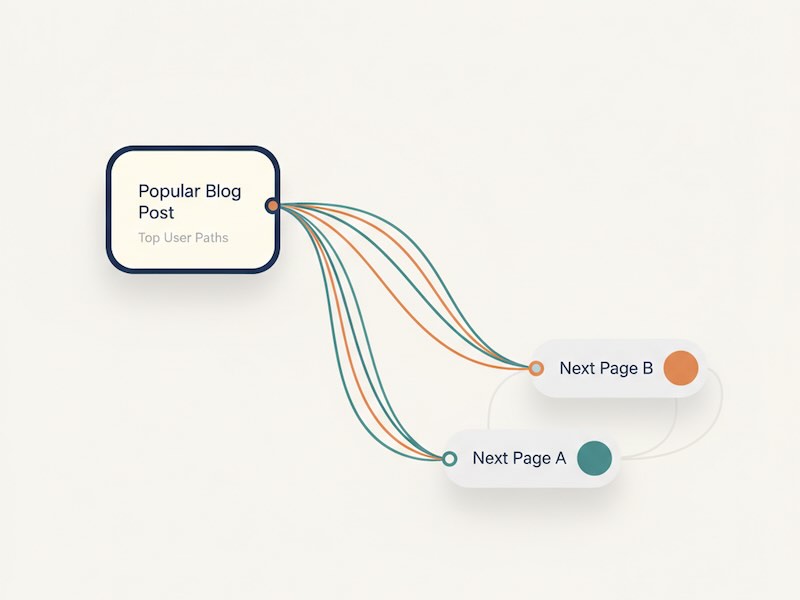You don’t need a data team to figure out your next winning post. A handful of simple signals—readily available in most analytics tools, inboxes, and comments—can tell you what readers are itching to read next. Here’s a practical, no-jargon guide you can run through in under an hour each week.
The mindset: follow the breadcrumbs, not your hunches
Your audience already leaves clues: which pages they linger on, which sections they bail from, questions they ask in comments, even the links they click when they’re done with a post. Treat each clue as a “topic seed” and ask: what’s the natural next question this reader would have?
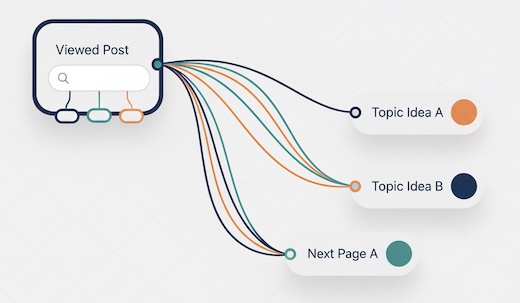
The Signal-to-Topic Table
| Signal (What you notice) | Where to look | What it likely means | “Next article” prompt you can use |
|---|---|---|---|
| One post has unusually high time on page and scroll depth | Page-level engagement metrics | Readers are engaged but still exploring | “What’s the advanced/part-2 version of this topic?” |
| Spikes in traffic from specific keywords or search snippets | Acquisition reports, Search Console, referrers | People discover you for a specific question | “Write the adjacent questions a searcher would ask next.” |
| On-site search queries after reading a post | Internal search terms/report | The post created curiosity but didn’t answer all angles | “Create a follow-up that directly answers the top 5 searches.” |
| Repeated questions in comments/email replies | Comments, inbox, social DMs | Real obstacles or confusion points | “Turn the most common question into an explainer with examples.” |
| Exit clicks to certain links (tools, templates, vendors) | Outbound link/exit reports | Readers want practical help/resources | “Make a resource roundup, template, or comparison they can use.” |
| High bounce but long time on page | Behavior/engagement overview | The post is a stand-alone keeper; readers may be satisfied but not guided | “Add a ‘next step’ post that extends the journey (checklist, case study).” |
| Low time on page but many shares | Social share data, UTM campaigns | Skimmers share “headline value” but content may be top-funnel | “Publish a deeper dive that validates the hype with data.” |
| Seasonal lifts on certain topics | Year-over-year charts | Timing matters (holidays, budgeting, launches) | “Plan a timely series for the next seasonal window.” |
Tip: copy this table into your notes and jot 1–2 potential headlines in the last column each week.
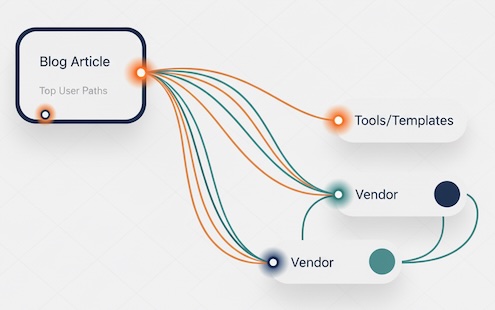
Eight fast idea sources
- Top pathways, not top pages
Look at the sequence of pages (entry → next page).
Prompt: “Readers of Beginner’s SEO most often move to Keyword Research 101—create Keyword Research Mistakes as a natural follow-up.” - Internal search mini-goldmine
Review queries typed into your site search, especially after reading a post.
Prompt: “After ‘GA4 basics,’ people search ‘events vs conversions’—write ‘GA4 Events vs. Conversions: Plain-English Examples.’” - Scroll drop-offs = content cliffhangers
If many readers drop at the same subsection, they either got their answer—or hit friction.
Prompt: “Turn that subsection into its own post with more examples and a downloadable checklist.” - Outbound link heat
Which external links get the most clicks? Tools, calculators, and templates inspire action.
Prompt: “Create a side-by-side comparison or a ‘how to choose a tool’ guide.” - Comment clouds
Cluster similar questions from comments and email replies.
Prompt: “Bundle 5 recurring questions into one ‘Reader Q&A’ piece; each answer can become a future deep dive.” - Search Console “almost there” terms
Terms where you rank on page 2–3 mean interest is proven; your post may lack angles users want.
Prompt: “Add a post targeted at the ‘how much / how long / vs alternative’ intent around that term.” - Social saves and replays
Saves (and video replays) signal utility beyond clicks.
Prompt: “If a short tip gets many saves, expand it into a long-form tutorial with examples and pitfalls.” - Email link friction
In newsletters, note links with high hover or near-click behavior (if available) but average CTR.
Prompt: “The curiosity is there; the promise isn’t clear—write a clearer, narrower post that matches the curiosity.”
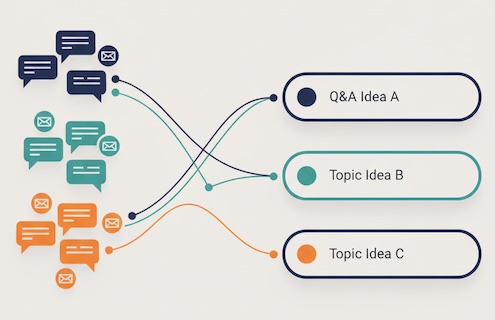
Quick frameworks to convert signals into headlines
- Problem → Micro-Outcome
“Struggling with X? Here’s how to get Y in 15 minutes (without Z).” - Seed Topic → Adjacent Topic
“You learned A; now let’s tackle B (the part everyone trips on).” - Data → Decision
“What the numbers say about choosing between Option 1 and Option 2.” - Template First
“Steal This Template: The [Process] Doc We Actually Use (with examples).”
Reader intent ladders: build the next rung
Most topics climb a simple ladder:
- What is it?
- Does it apply to me?
- How do I start?
- How do I avoid mistakes?
- How do I scale or optimize?
Find which rung your popular post sits on; the next post is usually the rung above or below. For example, if your hit post is “How to Start with Internal Links,” the natural follow-ups are “Internal Linking Mistakes to Avoid” (rung 4) or “Internal Linking at Scale” (rung 5).
A 30-minute weekly ritual
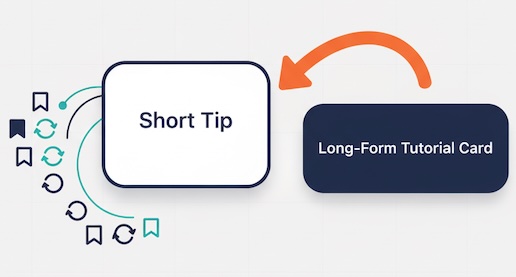
- Skim dashboards (10 min):
- Top paths, on-site search terms, exit clicks from your top 10 posts.
- Collect human signals (10 min):
- 5 newest comments, 5 email replies, 5 social DMs.
- Pick 3 seeds (5 min):
- Choose the ideas that repeat or cluster.
- Draft 3 headlines (5 min):
- Use the frameworks above; sanity-check against your table.
Pin this ritual to your calendar. Momentum beats inspiration.
Pitfalls to avoid
- Chasing outliers: Don’t build a series around a one-day spike from a random mention; look for multi-week patterns.
- Over-indexing on vanity metrics: Shares without reads, or impressions without engagement, often yield shallow follow-ups.
- Answering everything in one post: If a section keeps attracting attention, split it. Depth wins.
- Copying competitors blindly: Use competitor topics as context, not commandments. Your readers’ breadcrumbs matter more.
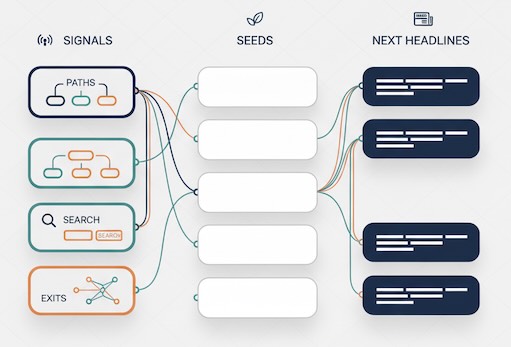
Example: turning one post into a month of content
- Hit post: “Beginner’s Guide to Technical SEO”
- Signal A: On-site search terms include “xml sitemap,” “core web vitals”
- Signal B: Exit clicks to a CWV testing tool
- Signal C: Comments ask “what’s a good LCP?”
Month plan:
- Week 1: “XML Sitemaps in Plain English (What They Are and When They Matter)”
- Week 2: “Core Web Vitals: Benchmarks That Actually Predict Conversions”
- Week 3: “LCP, CLS, INP: Good vs. Good Enough—How to Prioritize”
- Week 4: “Tool Showdown: Free Ways to Check Performance (Pros and Cons)”
Every title flows from real signals—not guesses.
The takeaway
Your next great topic is usually hiding in plain sight: inside scroll patterns, on-site searches, exit links, and reader questions. Systematically collect those breadcrumbs, map them to the next rung of intent, and you’ll build an editorial pipeline that feels obvious to readers—because it’s based on what they already told you, with their clicks and their words.

